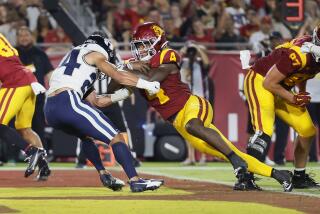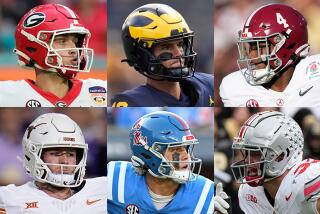College Football Struggles With Math to Find No. 1
- Share via
Each year at this time, Dr. Peter Wolfe receives e-mail from people who consider him an idiot.
They couldn’t care less that he is an infectious-disease specialist who treats AIDS patients. They probably don’t know that he speaks French and Portuguese and is a fan of Brazilian literature. Or that he is a pilot and classical pianist.
“It is a little bracing to look at your inbox and see these people threatening you,” he said. “The obscenities and all that.”
None of his accomplishments matter, because the Beverly Hills doctor has a computer program that ranks college football teams. Only a hobby, it is respected enough to be used by the bowl championship series, or BCS, in selecting teams for the top bowl games at season’s end.
And that is where Wolfe runs into problems.
While any sports ranking is bound to spark barroom arguments, the BCS has been particularly criticized for the dizzying way it combines polls, computer ratings and mathematical formulas. Some fans claim it favors traditional powerhouses such as Oklahoma and USC -- which rose to No. 2 last week -- excluding smaller schools from the big-money games.
Opinions run so hot that Congress recently held hearings on the matter. Sen. Joseph R. Biden Jr. (D-Del.) said the BCS “looks un-American ... it looks like a rigged deal.”
Not the place you’d expect to find a 49-year-old, Harvard-educated physician. Wolfe said diplomatically: “People feel so strongly about it.”
Arguing has always been part of the game because college football is the only major sport without a championship playoff. When Wolfe was growing up in Pittsburgh -- too small to play, scouring the Sunday paper for scores -- there was no BCS.
Winning teams were scattered among various bowls and rarely did the top two meet. The national champion was determined not on the field, but by sports reporters and coaches voting -- and sometimes disagreeing -- in separate polls.
Even as Wolfe went through medical school and became a doctor, he pondered a better method. He wasn’t alone.
Before the 1998 season, the six largest conferences and independent Notre Dame joined the four largest bowl games -- the Rose, Fiesta, Sugar and Orange -- to form the BCS. Their goal was to match the No. 1 and 2 teams in a title game that would rotate among the participating bowls.
Roy Kramer, then commissioner of the Southeastern Conference, led the new alliance. Brainstorming with his staff, he posed a simple question: If several teams finished 10-1, how to choose among them?
“During one summer, we spent four to five hours a day for three months,” said Charles Bloom, an associate commissioner. “There was a lot of research.”
They devised a method that works like golf -- low score is best. Each team is ranked by not only wins and losses but also:
* An average of its rankings in the media’s Associated Press poll and the coaches’ ESPN/USA Today poll.
* An average of its ratings by seven computer services, subtracting the lowest number for each team. These services rely not on votes but on dispassionate, though oft-questioned, statistical programs.
* Strength of schedule. A team that plays strong opponents receives more credit than a team that loads its schedule with creampuffs.
* Bonus credit is given for victories over teams that finish in the BCS top 10.
“We didn’t want a system that was too complicated,” Bloom said. “If you have a system that determines the national championship, you have to be able to sell it to fans.”
But in its five-plus seasons, the BCS has proved neither straightforward nor an easy sell.
Though most agree that the best teams have won the title, there have been glitches and the strength-of-schedule factor has been confusing. For example, in its first game this season USC scored a valuable win over highly ranked Auburn. But Auburn subsequently has lost three more games and tumbled out of the rankings, retroactively decreasing the worth of USC’s victory.
Even worse, critics have bristled at sometimes curious results delivered by the computers.
By the time the BCS came along, Wolfe had moved to Los Angeles, gone into practice and become a UCLA fan. He had also stumbled upon others like him -- what he calls the “sports rating subculture.”
The Internet bustled with Web sites and literature on formulas borrowed from business and other applications.
Wolfe chose something called a “maximum likelihood estimate,” which he insists is simple but can seem ponderous to the uninitiated. It relies upon common opponents.
“Like six degrees of separation,” he said. “Even though UCLA doesn’t play Occidental, you can eventually connect them.”
So his boyhood pursuit of scores continued. Friends and family became resigned to his spending Saturdays, from afternoon until midnight, holed up in the bedroom with a television and computer, keeping tabs on all the games.
In 1998, with the onset of the BCS, he began posting his results on a Web site run by a well-known computer rater, Kenneth Massey. In the spring of 2001, the phone rang at his medical practice. Kramer was on the line.
Computer ratings had come under fire the previous season, when they put Florida State in the title game instead of Miami, a team Florida State had lost to weeks earlier.
Still, the BCS wanted more computer ratings and invited Wolfe to join. In his first season, the computers sent Nebraska to the championship game instead of Oregon, which was ranked second in both polls.
The e-mails began.
“They would ask me, ‘How much are they paying you to be crooked?’ ” Wolfe said. “Or, ‘Let’s have a whistle-blower suit.’ ”
Critics have found other reasons to complain. The BCS reshuffles the matchups in its four affiliated bowls, which means the Rose Bowl is no longer guaranteed a traditional Pacific 10-Big Ten game on New Year’s Day.
Just as vexing is the issue of money.
The BCS generates more than $100 million in annual revenue, most of which comes from ABC for rights to televise the four highly watched games. In a payout system as complex as the rankings, the money then goes to the conferences.
A conference receives $13.8 million if one of its teams plays in a BCS bowl, $21.5 million for two. Each conference decides how to split the cash among its schools.
There is a slightly different arrangement for paying Rose Bowl teams.
When all is said and done, only $6 million remains to be shared by five smaller conferences -- that’s 54 teams -- not in on the BCS deal. Theoretically, those teams can earn at-large spots in BCS bowls, but it has yet to happen.
This summer, presidents from non-BCS schools formed a coalition to argue that the BCS is a monopoly. Thus the legislative hearings and Biden’s comments.
“I don’t think you can deny that it’s a big deal,” said Daniel Fulks, a professor at Transylvania University in Lexington, Ky., who studies the business of college sports. “The moneymakers are the BCS teams.”
It is unlikely any changes will occur until the television contract runs out in early 2006.
The BCS’ troubles were no secret to Wolfe when Kramer called. He also knew there was no salary for joining. But it seemed like too much fun.
Each Sunday, with hundreds of scores entered into his bedroom computer, he pushes a button and -- like any college football fanatic -- waits to see the rankings.
The thrill is just enough to outweigh the vitriol.
Attacks began during his first season when Brigham Young won game after game and his computer consistently rated the team low. “I got a lot of e-mail from those guys,” he said, then added: “Until Dec. 1 when they went to Hawaii and gave up 70 points.”
This season hasn’t been easier. “Maybe Dr. Peter Wolfe should stick to medicine,” John Henderson of the Denver Post wrote two weeks ago. “His computer rankings look as if he used a dartboard instead of a computer.”
While USC is No. 2 in both polls and the BCS rankings, the Trojans fare no better than No. 5 on his computer. Much has been made of the fact Wolfe is a Bruin fan and occasional professor at UCLA’s medical school.
The pressure could increase with new rankings coming out today. Ohio State has one loss, just like USC, but plays a tougher schedule in these final weeks of the season and, because of the BCS formula, could inch up on the Trojans.
Mindful of the nastiness he has already endured, Wolfe declined to talk about his family, saying, “They don’t deserve this.” Asked if he would allow a photograph to be taken for the newspaper, he shouted: “No.”
He would understand if fans took umbrage with the algorithm he chose to rate teams, but it irks him to be accused of bias.
“There is no favoritism,” he said. “There is no animus toward any team, be they named Trojans or not.”
The computer, he said. doesn’t even distinguish between the Trojans of USC and similarly named teams at Dakota State, Troy State, Virginia State and Trinity International.
Of course, the man running the machine was smart enough to know the difference this season when USC lost to California, a defeat that weighed on his ratings.
“If USC beats Cal,” he said, “I don’t get as many e-mails.”
*
(BEGIN TEXT OF INFOBOX)
Deciphering the BCS
Five elements are used to determine bowl championship series standings, in which lowest point total is best:
1. Poll average: Average of AP media poll and ESPN/USA Today coaches’ poll.
2. Computer average: Arrived at by averaging six of seven computer rankings, disregarding the lowest.
3. Schedule rank: Rank of schedule strength compared to other Division I teams. This is based on the cumulative win-loss records of a team’s opponents (66.6 percent) and the cumulative win-loss records of the opponents’ opponents (33.3 percent).
4. Losses: One point for each loss during the season.
5. Quality win component: This rewards a team that defeats opponents ranked among the top 10 in the BCS standings at the end of the season. A maximum of 1.0 points is deducted for a win over the No. 1 team, and 0.1 points for a win over the No. 10 team.
Dr. Wolfe vs.
the BCS Top 15
Dr. Wolfe’s Nov. 3 rankings (in parentheses) compared to the top 15 BCS teams:
1. Oklahoma (1)
2. USC (5)
3. Florida State (4)
4. Miami (3)
5. Ohio State (2)
6. Virginia Tech (6)
7. Louisiana Tech (7)
8. Michigan (10)
9. Texas Christian (8)
10. Georgia (12)
11. Iowa (9)
12. Texas (14)
13. Tennessee (19)
14. Purdue (18)
15. Washington St. (23)
Sources: Los Angeles Times, Associated Press
More to Read
Go beyond the scoreboard
Get the latest on L.A.'s teams in the daily Sports Report newsletter.
You may occasionally receive promotional content from the Los Angeles Times.











